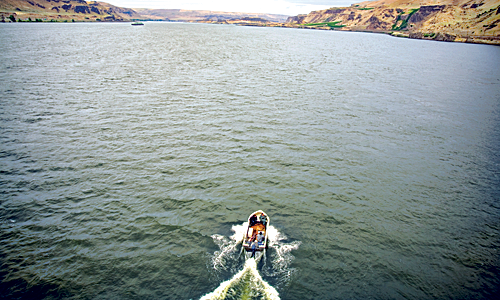forum
library
tutorial
contact

Restoring Wild Salmon
Means Restoring Wild Rivers
by Joseph Friedrichs
Plenty, February 27, 2008
|
the film forum library tutorial contact |

|
Restoring Wild Salmon
by Joseph Friedrichs
|
Tribes in the Pacific Northwest are banding together to boost the fish populations
that are central to their culture and economy
 Each spring tribal communities in the Columbia River basin in the Pacific Northwest host a salmon feast honoring the sacrifices the fish make for the welfare of the Yakama, Nez Perce, Umatilla, and Warm Springs tribes. The fishing communities rely on the once-bountiful salmon to support their livelihood. But several years, ago salmon runs were so low that they had to buy the fish in order to have enough for the feast.
Each spring tribal communities in the Columbia River basin in the Pacific Northwest host a salmon feast honoring the sacrifices the fish make for the welfare of the Yakama, Nez Perce, Umatilla, and Warm Springs tribes. The fishing communities rely on the once-bountiful salmon to support their livelihood. But several years, ago salmon runs were so low that they had to buy the fish in order to have enough for the feast.
The scarcity of salmon is not new. For hundreds of years the fish have been vital to the culture, economy, diet, and religion of the four tribes. But last century, America's charge for hydroelectric power traveled west, and dam construction radically altered the mighty Columbia River and its tributaries. The Dalles Dam, built in 1957, drowned Celilo Falls, a stretch of river once heralded as "the Wall Street of the West" because of its supreme fishing. One of the most notorious fisheries of the West vanished, and energy development continued at the expense of tribal communities.
"We rely on the salmon for our ceremonies, subsistence, and livelihood," says Fidelia Andy, chairwoman of the Columbia River Inter-Tribal Fish Commission, a nonprofit created by members of the four tribes. Because of their inherent sovereignty, like federal agencies, Columbia Basin tribes are responsible for protecting the fish. The Commission's fish biologists, hydrologists, and other scientists are working to save the salmon by preserving their habitat, devising management plans, and restoring the area's waterways to their natural condition. Now, they are pushing the federal government to ensure its new salmon management plan is in line with their own.
The Commission's roots go back to the late 1970s during a period Olney Patt Jr., the group's executive director, describes as "a time of turmoil for the environment and the tribes," when utilities built numerous dams and reckless irrigation practices formed. As a result, salmon runs that once numbered in the millions dropped on the affected waterways to the low thousands, hundreds, or in some cases, none at all.
The Commission has now joined forces with conservation groups and businesses to restore the salmon's spawning habitat throughout the Columbia River basin through habitat conservation, monitoring, and education. The main objective of the group's salmon restoration plan (called Wy-Kan-Ush-Mi Wa-Kish-Wit, "Spirit of the Salmon") is to halt the decline of salmon populations above Bonneville Dam in the Columbia within seven years. The group also aims to rebuild salmon populations to annual run sizes of four million above Bonneville Dam within 25 years. Accomplishing that goal could mean breaching four dams along the Snake River, the Columbia's largest tributary. A breach consists of removing a portion of the dam, in this case allowing salmon to travel more easily up and downriver.
Nearly all anadromous fish-those, like salmon, that spend their adult life in salt water and return to freshwater to breed-that pass over the dams in the river basin are listed as threatened or endangered. Given this status, the federal government must protect the fish under the Endangered Species Act. NOAA Fisheries, the federal agency in charge of restoring salmon populations, is currently devising a plan to protect and recover salmon stocks, which may include habitat enhancements and breaching the dams, a notion that has some landowners who rely on set irrigation patterns less than pleased.
Bruce Suzumoto, NOAA's assistant regional administrator in the Pacific Northwest, says his organization is working to make "the best plan possible for all parties involved," including the Commission and the Bonneville Power Administration, a federal agency that operates federal dams in the Pacific Northwest.
"We're going to do our best with the information we have and comments we've received," he says. "It's never going to be perfect."
Last year NOAA received some 16,700 e-mails with one underlying theme: remove the dams. Nearly all of the messages read: "removal of the four lower Snake River dams must be a cornerstone of any truly effective salmon and steelhead plan." Along those lines, the Commission delivered 141 pages of commentary along with about 500 pages of appendices to NOAA. In response, the federal agency has twice pushed back its decision; the deadline is now May 5.
NOAA's delays "are steps backwards," says Nicole Cordan, policy and legal director for Save Our Wild Salmon Coalition, a nationwide organization working to restore salmon to rivers and streams of the Pacific Northwest.
Patt sees the delays as time needed for NOAA to go through the comments. "They've received so many," he says. For their part, the Commission is hopeful the agency's decision will complement their own management plan-both for the survival of the rivers and the tribes.
"Economically, the low salmon populations have really hurt the tribal fishers that rely on fishing for an income," says N. Kathryn Brigham, the Commission's vice chair. "Some years tribal fishers struggle to cover their expenses to fish. Fewer fish means less financial support is being put back into the tribal economy."
learn more on topics covered in the film
see the video
read the script
learn the songs
discussion forum
